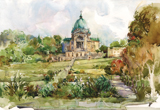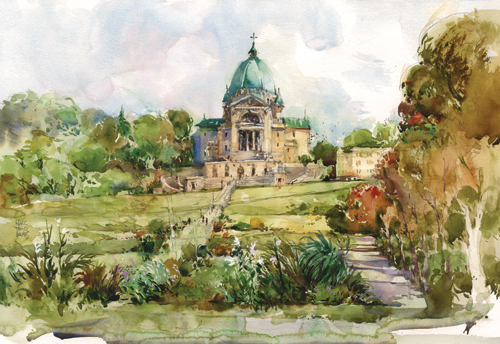Urban Sketcher Marc Taro Holmes’ Tea, Milk and Honey Technique for Applying Watercolor

The Urban Sketcher Talks About an Odd Process That Yields Amazing Watercolor Results
Sometimes it is the weird and offbeat approaches that stick in my head and make the most sense. Urban sketcher Marc Taro Holmes is cut from the same cloth. I knew from the moment he offered to share his three-pass tea, milk and honey watercolor technique of applying color.
I said, “What?!” But when he explained it, the whole world of watercolor opened up a little bit more for me. It was like going from black and white to Technicolor. See if Marc’s approach sticks in your mind like it has in mine!
Fluid, Opaque, Rich and Sticky
Marc refers to watercolor washes as “tea,” “milk” and “honey” to correlate with their translucency, coverage and application. Tea is a very fluid wash; milk, on the other hand, is a bit more opaque, requiring less water and more paint; and honey is a rich, sticky mix of paint and a minimal amount of water applied sparingly.
Basically, he works from lighter to darker and larger to smaller, beginning with tea, which is followed by milk and then honey. The initial tea wash covers the entire composition with large shapes. The following passes of milk and honey cover the underlying tone, building strength and solidity in the shadows.
LINE SKETCH

Knowing that he is going to do most of the work with watercolor, Marc doesn’t put more effort than necessary into his drawing. It’s just a clean, fairly descriptive pencil drawing that includes the major outlines of color shapes. This scene was at midday with the sun behind a thin haze of cloud, calling for a generalized glaze everywhere and a washed-out sky.
FIRST PASS: TEA


The transparent tea mix should flow freely and tint—but not obliterate—the drawing. Apply the color wash quickly. See how Marc works the three big shapes in the image wet-into-wet while staying loose and splashy with lots of color variation.
Also, attempt to keep the dry edges between the live shapes sharp. And work quickly! Marc spread the wash over the entire image in 5 minutes or less, but the combination of swiftness and accuracy takes some practice.
While working, stay aware of the color variation and go back for a slightly different hue each time, modifying the base color with warm and cool neighbors. Notice that Marc left a few small flecks of white throughout the midground to create random glints. A wash should never be too smooth or perfect.
CRITIQUE: Marc assessed his painting at this stage and says: “I should have hit a richer color in the sky, because it’s too pale, and the warm white of the stone building is too bleached out. Mostly, though, I find it’s important to accept whatever happens at this stage.”
SECOND PASS: MILK


After the tea pass dries, move to the second pass of color—milk. It needs enough paint to be cloudy to cover what’s gone before. Work from lighter to darker with this wash; you only need to deepen midtones and shadow shapes.
Be careful to leave the lit areas alone and let the tea stain glint through. For this pass, you don’t want uniform coverage; instead, create a light-dappled texture, letting the layers intersect. Allowing little gaps in this pass created the illusion of light bouncing off the upward-facing surfaces.
Don’t hold back on the paint in this pass! Remember how little honey there is in a cup of tea (or the final pass). The darkest darks are only for the final pop of contrast.
This stage is the most fun for Marc, as there’s a lot of exciting brush calligraphy and charging-in.
THIRD PASS: HONEY


After letting the milk pass dry, move on to the honey pass. If you think about Marc’s analogy, there’s usually just one teaspoon of honey in a cup of tea. It’s the same for creating the darkest darks when painting—a little goes a long way. They’re only two to three percent of a typical sunlit image. Even when a subject is dark and shadowy, the spot blacks are only for the deepest contact shadows.
A sketch doesn’t really come together until the darks are properly placed, because they’re the basis of the gradient of interest. We know the weight of the darkest darks attract the eye. In a painting like this, the viewer’s eye will travel from eye magnet to eye magnet, moving around the space.

The honey pass is the mostly about the deepest darks, but it’s also the last chance to re-touch the lightest lights. Marc uses white gouache mixed to a honey consistency–thick and sticky–to sketch in the lilies in the flower bed.
 For a more in-depth look at Holmes’ tea, milk and honey approach, as well as urban sketching techniques, tips, exercises and more, turn to The Urban Sketcher. Throughout the book, Marc proves himself to be an exciting and engaging art instructor who makes the process of drawing and painting exciting and understandable. You’ll enjoy the resource cover to cover. Guaranteed!
For a more in-depth look at Holmes’ tea, milk and honey approach, as well as urban sketching techniques, tips, exercises and more, turn to The Urban Sketcher. Throughout the book, Marc proves himself to be an exciting and engaging art instructor who makes the process of drawing and painting exciting and understandable. You’ll enjoy the resource cover to cover. Guaranteed!
Courtney






Have a technical question?
Contact UsJoin the Conversation!